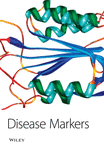Effect Of Interferon-γ and TNF-α on MUCl MUCIN Expression in Ovarian Carcinoma Cell Lines
Abstract
In view of the potential uses of cell surface tumour associated antigens in novel anticancer treatment. a study was designed to investigate whether the biological response modifiers interferon-gamma (IFN-γ) and tumour necrosis factor-alpha (TNF-α) could effect the expression of an epitope on the tumour associated MUC I epithelial mucin. Four ovarian carcinoma cell lines showing high (OAW42 and GG) and low (JAM and PEO1) basal expression of MUC1 were treated with 10-1000 U/mL of IFN-γor TNF-α for one or five days. Changes in MUC1 expression in cells exposed to IFN-γ or TNF-α were monitored using an ELISA technique with the monoclonal antibody BC2 which reacts with a core protein epitope on the MUC1 mucin, and then corrected for the number of viable cells present. TNF-α had little effect on MUC1 expression, but one or five days exposure to IFN-γ significantly increased MUC1 expression (p < 0.01) in all cell lines including the two cell lines that initially showed little or no expression.




